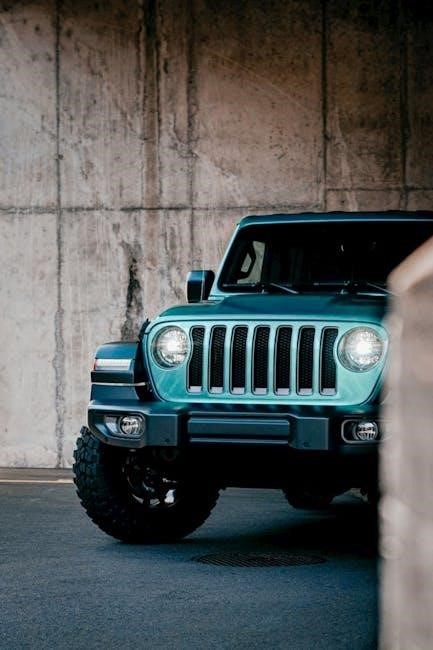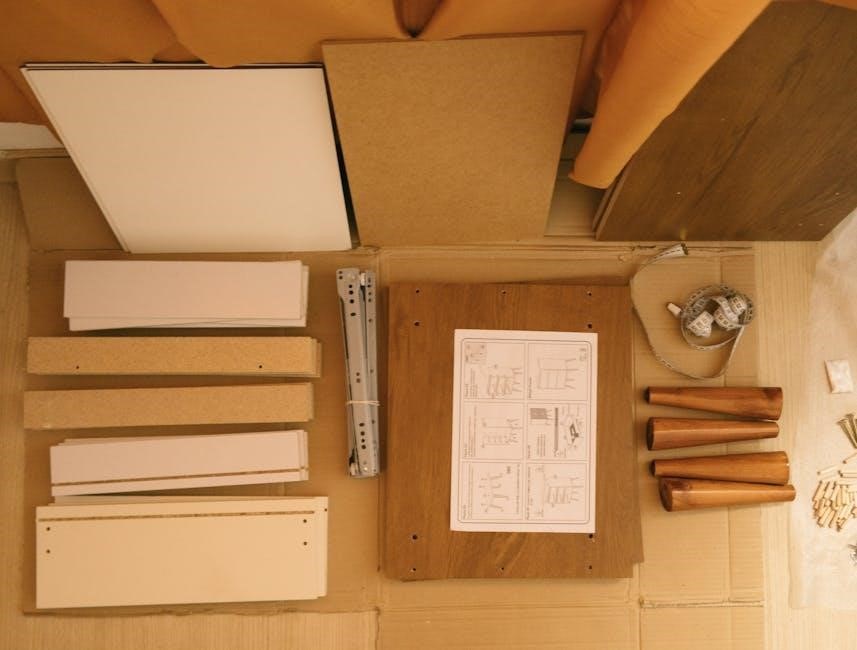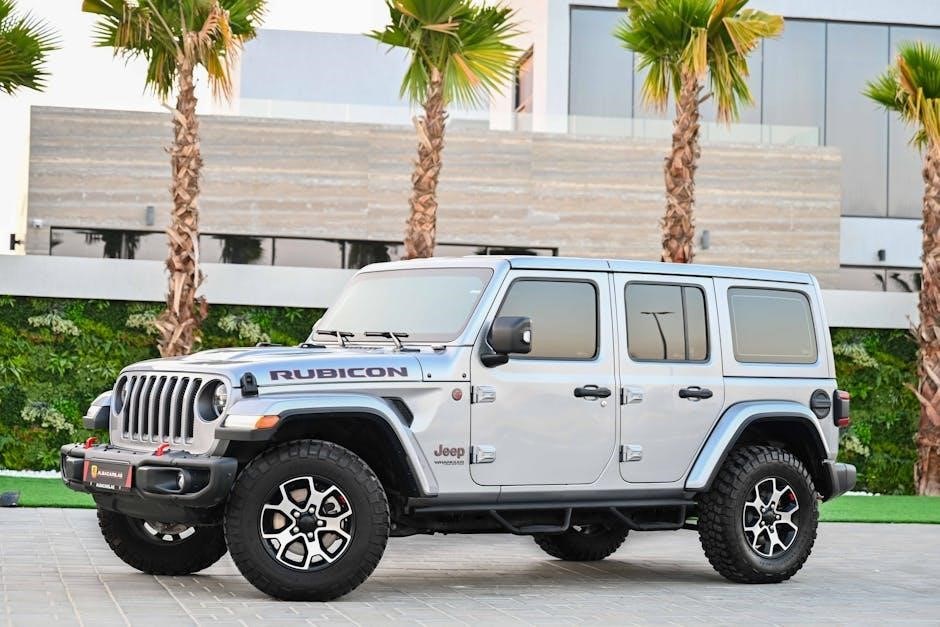
jeep wrangler jk hardtop seal kit instructions
Want to restore your JK Wrangler to its original, leak-free condition? Replacing worn hardtop seals is key! Several kits offer solutions, like Mopar’s Foam Blocker Seal Kit (68026937AB) for Freedom Panels. Proper installation is crucial to stopping leaks.

Identifying Leak Sources in JK Hardtops
Pinpointing the exact location of a leak in your Jeep Wrangler JK’s hardtop is the first crucial step before diving into seal replacement. Water intrusion can manifest in various areas, each indicating a potential problem with specific seals or the hardtop itself. Common areas to inspect include the Freedom Panel seals, the main hardtop-to-body seal, and the rear window seal. Carefully examine these areas for signs of wear, damage, or improper sealing. Look for water stains on the interior, dampness on the carpet or seats, or even the presence of mold or mildew. Pay close attention to the seams and edges of the hardtop, as these are often the weakest points in the weather sealing. During rain or after a car wash, observe where water is entering the cabin. Is it dripping from the headliner, running down the windows, or pooling on the floor? The location of the water entry point will provide valuable clues about the source of the leak. The Freedom Panels, being removable, are a frequent culprit. Check the seals around their perimeter for cracks, tears, or compression. Also, ensure that the panels are properly aligned and secured. The main hardtop-to-body seal, which runs along the entire perimeter of the hardtop where it meets the Jeep’s body, is another critical area. Inspect this seal for damage, deformation, or gaps. If the seal is old or worn, it may have lost its elasticity and ability to create a watertight barrier. The rear window seal can also be a source of leaks, especially if it’s cracked or improperly installed. Don’t forget to check the drain holes in the hardtop, as clogs can cause water to back up and leak into the cabin. By thoroughly inspecting these areas and carefully observing the water’s entry point, you can accurately identify the source of the leak and determine which seals need to be replaced.


Types of Seal Kits Available for JK Hardtops
Addressing leaks in your Jeep Wrangler JK hardtop requires selecting the appropriate seal kit, as various options cater to different areas and needs. Generally, seal kits can be categorized based on their coverage and the specific components they include. Some kits offer a comprehensive solution, replacing all the major seals on the hardtop, while others target specific areas prone to leaks, such as the Freedom Panels or the rear window. A comprehensive hardtop seal kit typically includes seals for the Freedom Panels, the main hardtop-to-body seal, and the rear window seal. These kits are ideal if you’re experiencing multiple leaks or if the existing seals are generally old and deteriorated. They provide a complete refresh of the hardtop’s weather sealing, ensuring optimal protection against water and wind intrusion. For those primarily concerned with leaks around the Freedom Panels, dedicated Freedom Panel seal kits are available. These kits usually include replacement seals for the perimeter of the panels, as well as any necessary adhesive or hardware for installation. They are a cost-effective solution if the Freedom Panels are the sole source of the leaks. Similarly, rear window seal kits are designed specifically for replacing the seal around the rear window of the hardtop. These kits are suitable if the rear window seal is cracked, damaged, or no longer creating a tight seal. In addition to these specific kits, some manufacturers offer universal seal kits that can be cut and customized to fit various areas of the hardtop. These kits typically include a roll of weather stripping material and adhesive, allowing you to create custom seals for any gaps or leaks you may encounter. When choosing a seal kit, consider the quality of the materials used. Look for seals made from durable rubber or foam that can withstand exposure to the elements and maintain their elasticity over time. Also, check whether the kit includes adhesive or hardware for installation, as these may be required for proper sealing. Some popular brands offering seal kits for JK hardtops include Mopar, Omix-Ada, and RedRock. Researching the different options and reading customer reviews can help you select the best seal kit for your specific needs and budget.

Essential Tools for Hardtop Seal Replacement
Successfully replacing the seals on your Jeep Wrangler JK hardtop requires having the right tools on hand. While the specific tools needed may vary slightly depending on the type of seal kit you’re using and the condition of your existing seals, there are some essential items that will make the job easier and ensure a professional-quality result. First and foremost, you’ll need a set of basic hand tools, including screwdrivers (both flathead and Phillips head), sockets, and wrenches. These tools will be used for removing any hardware that may be holding the old seals in place, as well as for installing any new hardware that comes with the seal kit. A plastic scraper or putty knife is essential for carefully removing the old seals without damaging the hardtop surface. Avoid using metal scrapers, as they can scratch or gouge the paint. A heat gun or hair dryer can be helpful for softening the adhesive on the old seals, making them easier to remove. Apply heat gently and evenly to avoid damaging the hardtop. A solvent or adhesive remover is necessary for cleaning the hardtop surface after the old seals have been removed. This will remove any remaining adhesive residue and ensure a clean surface for the new seals to adhere to. Isopropyl alcohol or a dedicated adhesive remover can be used. Clean rags or paper towels are essential for wiping down the hardtop surface and applying the solvent or adhesive remover. A measuring tape or ruler is needed for accurately measuring and cutting the new seals to the correct length, especially if you’re using a universal seal kit. Scissors or a utility knife are necessary for cutting the new seals to size. Ensure the blades are sharp for clean and precise cuts. A caulking gun may be required if the seal kit includes a tube of sealant or adhesive. This will allow you to apply the sealant evenly and precisely. Safety glasses and gloves are essential for protecting your eyes and hands during the seal replacement process. The old seals may contain debris or chemicals that can be harmful, so it’s important to take precautions. Finally, a torque wrench may be needed for tightening any hardware to the correct specifications. Consult the vehicle’s service manual for the recommended torque values. Having these essential tools on hand will make the hardtop seal replacement process smoother, more efficient, and safer, resulting in a professional-looking and leak-free hardtop.
Step-by-Step Guide to Removing Old Seals
Removing the old, worn-out seals from your Jeep Wrangler JK hardtop is a crucial first step in the replacement process. This step needs to be performed carefully to avoid damaging the hardtop surface. Here’s a detailed, step-by-step guide to help you through it: Preparation and Inspection: Begin by thoroughly inspecting the old seals to identify all areas that need to be removed. Take note of how the seals are attached and any specific challenges you might encounter. Gather your tools: plastic scraper, heat gun or hair dryer, solvent or adhesive remover, clean rags, and safety glasses/gloves. Softening the Adhesive: Use a heat gun or hair dryer to gently warm the old seals. Apply heat evenly to soften the adhesive, making it easier to remove the seals without tearing or leaving residue. Avoid overheating the area, as this could damage the hardtop paint. Initial Removal: Start by carefully prying up an edge of the old seal using a plastic scraper or putty knife. Work slowly and gently, applying steady pressure to avoid tearing the seal. If the seal is particularly stubborn, apply more heat to soften the adhesive further. Continued Removal: Once you’ve lifted an edge, continue working your way along the seal, gradually separating it from the hardtop surface. Use the plastic scraper to gently encourage the seal to release. If the seal tears, don’t worry – just continue working on the remaining sections. Removing Stubborn Sections: For sections of the seal that are particularly difficult to remove, try using a solvent or adhesive remover. Apply a small amount of the remover to the area and let it sit for a few minutes to loosen the adhesive. Then, use the plastic scraper to carefully remove the remaining seal. Hardware Removal (If Applicable): Some seals may be held in place by screws, clips, or other hardware. Use the appropriate tools (screwdrivers, sockets, etc.) to remove any hardware before attempting to remove the seal. Final Removal: Once you’ve removed all the old seals and any associated hardware, inspect the hardtop surface for any remaining adhesive residue or debris. Use a clean rag and solvent or adhesive remover to thoroughly clean the surface, ensuring it is smooth and free of any contaminants. Be patient and thorough throughout this process. Rushing can lead to damage to the hardtop. Take your time, use the right tools, and follow these steps carefully to ensure a clean and successful removal of the old seals.
Cleaning and Preparing the Hardtop Surface
After removing the old seals, thoroughly cleaning and preparing the hardtop surface is essential for ensuring proper adhesion of the new seals. This step will significantly impact the longevity and effectiveness of your new weatherstripping. Here’s a detailed guide: Initial Cleaning: Begin by wiping down the entire area where the old seals were located with a clean, dry cloth. This will remove any loose dirt, dust, or debris. A shop vacuum can also be helpful for removing small particles from hard-to-reach areas. Solvent Application: Choose a suitable solvent or adhesive remover specifically designed for automotive surfaces. Mineral spirits, isopropyl alcohol, or specialized adhesive removers are good options. Apply the solvent liberally to a clean rag. Removing Adhesive Residue: Gently scrub the areas where the old seals were attached, focusing on removing any remaining adhesive residue. Use circular motions and apply moderate pressure. For stubborn residue, allow the solvent to dwell on the area for a few minutes before scrubbing again. Repeat as needed. Addressing Stubborn Spots: If some adhesive residue proves particularly difficult to remove, consider using a plastic scraper in conjunction with the solvent. Be careful not to scratch the hardtop’s paint. A heat gun (used cautiously) can also soften stubborn residue, making it easier to remove with the scraper and solvent. Final Wipe Down: Once all adhesive residue has been removed, thoroughly wipe down the entire area with a clean, damp cloth. This will remove any remaining solvent and prevent it from interfering with the adhesion of the new seals. Drying the Surface: Allow the hardtop surface to air dry completely. You can expedite the drying process by using a clean, dry cloth or a low-heat hair dryer. Ensure the surface is completely dry before proceeding to the next step. Surface Inspection: Carefully inspect the cleaned surface for any imperfections, such as scratches, cracks, or uneven areas. Address any imperfections before installing the new seals. Minor scratches can often be buffed out with a polishing compound. Applying a Primer (Optional): In some cases, particularly if the hardtop surface is old or damaged, applying a primer specifically designed for automotive weatherstripping can improve adhesion. Follow the primer manufacturer’s instructions carefully. By taking the time to thoroughly clean and prepare the hardtop surface, you’ll create an ideal foundation for the new seals, ensuring a long-lasting, weather-tight seal that will protect your Jeep’s interior from the elements. A clean surface is paramount for proper adhesion and a professional-looking result.
Installation Guide for New Hardtop Seals
With the hardtop surface properly cleaned and prepared, you’re now ready to install the new seals. This process requires patience and attention to detail to ensure a weathertight fit. Here’s a comprehensive guide: Review the Seal Kit: Before you begin, carefully review all the components included in your hardtop seal kit. Identify each seal and its intended location on the hardtop. Refer to the manufacturer’s instructions or diagrams if provided. Some kits may include different types of seals for specific areas, such as the Freedom Panels or rear window. Test Fitting: Before removing the adhesive backing, test fit each seal in its designated location. This will help you ensure proper alignment and identify any potential issues. Pay close attention to corners and curves, ensuring the seal sits flush against the hardtop surface. Make any necessary adjustments before proceeding. Removing the Adhesive Backing: Once you’re satisfied with the fit, carefully peel back a small portion of the adhesive backing on the seal. Start at one end and gradually remove the backing as you apply the seal to the hardtop. Avoid removing the entire backing at once, as this can make the seal difficult to handle and increase the risk of contamination. Applying the Seal: Align the seal with its intended location and gently press it onto the hardtop surface. Use firm, even pressure to ensure proper adhesion. Work your way along the seal, gradually removing the adhesive backing and pressing the seal into place. Following Contours and Curves: When installing seals around corners and curves, take extra care to ensure a smooth, even fit. Gently stretch or compress the seal as needed to conform to the shape of the hardtop. Avoid creating any kinks or folds in the seal. A heat gun (used cautiously) can help soften the seal and make it more pliable. Sealing the Ends: Pay close attention to the ends of the seals, ensuring they are properly aligned and sealed. Some kits may include sealant or adhesive to help secure the ends. Apply the sealant or adhesive according to the manufacturer’s instructions. Inspecting the Installation: After installing all the seals, carefully inspect your work. Look for any gaps, uneven areas, or misalignments. If you find any issues, gently peel back the seal and reposition it as needed. Applying Pressure: Once you’re satisfied with the installation, apply firm pressure to all the seals to ensure proper adhesion. Use a clean roller or a soft cloth to press the seals firmly against the hardtop surface. Allowing Time to Cure: Allow the adhesive to cure completely before exposing the hardtop to the elements. Refer to the manufacturer’s instructions for the recommended curing time. By following these steps carefully, you can install your new hardtop seals with confidence, ensuring a weathertight seal that will protect your Jeep’s interior from the elements for years to come.
Maintenance Tips for Prolonging Seal Life
Specific Instructions for Freedom Panel Seals
The Freedom Panels on a JK Wrangler hardtop are a common source of leaks, making proper seal installation critical. These panels are removable, which means the seals endure more wear and tear than other areas of the hardtop. Here’s a detailed guide focusing specifically on Freedom Panel seal replacement: Identify the Correct Seals: Freedom Panel seal kits typically include several different seal types. Carefully identify which seals are specifically designed for the Freedom Panels. They often differ in shape and size from the seals used on the main hardtop body. Refer to the kit’s instructions or diagrams for accurate identification. Preparing the Freedom Panel Surface: Clean the surfaces on both the Freedom Panels and the corresponding area on the hardtop where the seals will be applied. Use a mild detergent and water to remove any dirt, grime, or old adhesive residue. Ensure the surfaces are completely dry before proceeding. Isopropyl alcohol can be used for a final cleaning to remove any remaining contaminants. Test Fitting the Seals: Before removing the adhesive backing, test fit the new seals on the Freedom Panels and the hardtop. Pay close attention to the alignment and fit. The seals should sit snugly against the surface without any gaps or overlaps. Make any necessary adjustments before proceeding. Applying the Seals to the Freedom Panels: Most Freedom Panel seals have an adhesive backing. Carefully peel back a small portion of the backing and align the seal with its designated location on the Freedom Panel. Press the seal firmly into place, working your way along its length. Avoid stretching or distorting the seal during installation. Applying the Seals to the Hardtop (if applicable): Some Freedom Panel seal kits include seals that attach to the main hardtop body, creating a mating surface for the Freedom Panels. Follow the same procedure as above, carefully cleaning the surface, test fitting the seals, and applying them with firm, even pressure. Paying Attention to Corners and Curves: The corners and curves of the Freedom Panels can be challenging to seal properly. Take extra care when installing the seals in these areas. Gently stretch or compress the seal as needed to conform to the shape of the panel. Use a heat gun (on a low setting) to make the seal more pliable if necessary. Ensuring Proper Compression: The Freedom Panel seals need to compress adequately when the panels are installed to create a weathertight seal. Check the thickness and density of the new seals to ensure they are sufficient to fill the gap between the panels and the hardtop. Testing for Leaks: After installing the Freedom Panel seals, test for leaks by spraying water over the hardtop while someone inside checks for any water intrusion. If you find any leaks, carefully inspect the seals and make any necessary adjustments. Using Additional Sealant (Optional): For added protection against leaks, you can apply a thin bead of silicone sealant along the edges of the Freedom Panel seals. This will help create a tighter seal and prevent water from seeping through any small gaps. Remember to use a sealant that is compatible with rubber and plastic. By following these specific instructions, you can effectively replace the Freedom Panel seals on your JK Wrangler hardtop and eliminate those annoying leaks.


Leave a Reply
You must be logged in to post a comment.